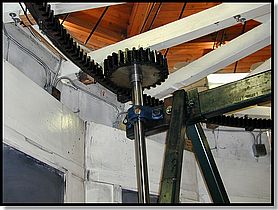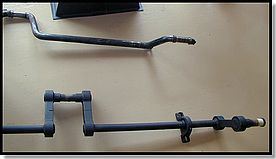 |
 |
 |
 |
Mechanical
|
It's rumored that, if you look closely, you'll see tears of joy in the
eyes of our carousel's maintenance technicians when you get them talking
about motors and cranks and all of the other greasy things that keep
our carousel turning!
They take pride in their job, which is quite different than keeping a '57
Chevy on the road. There are no carousel supply houses where you can go
to buy new shafts and gears for an '09 Looff. So, the maintenance tasks
often involve designing and fabricating parts before they can be replaced!
|
 Mike preparing to
Mike preparing to
install a new crank
|

New motor (left) and
old motor (right)
|
The original motor is still located in the center surround area.
It drove the carousel through a drive belt that was
connected to an idler wheel, and shifted to a drive wheel by a large lever
when it was time to start the carousel.
This motor served from 1909 until 1987, when it was replaced with a D.C. motor
that could be operated by a switch, eliminating the need for the lever and
drive belt. The original motor still works, and could be put back into
operation if ever there was a reason to do so.
|
|
A ring gear is driven by the D.C. motor's drive shaft and the attached
drive gear. The ring gear is attached to the upper carousel assembly,
which rotates when the motor turns. Power to the 180 light bulbs that
turn with the carousel is provided through a set of carbon brushes that rub
against a copper commutator.
|

Ring Gear
|

Original Drive Wheel (Left) and Idler Wheel (Right)
|
The original idler wheel and drive wheel are still in position inside
the center surround, and still lined up with the old motor. All that would
be required to activate them is to hook up a drive belt and disconnect
the new motor from the ring gear.
|
|
During 2004, four of the cranks were replaced with newly designed and fabricated
replacement parts. This turns out to be a large project because all three
horses riding on each crank have to be removed. It should be worth it, though.
We're expecting the new cranks to last another hundred years!
|

Old crank (above) and new crank (below)
|
|
 |
 |
 |
 |